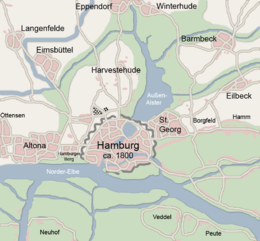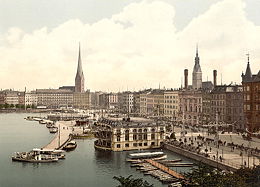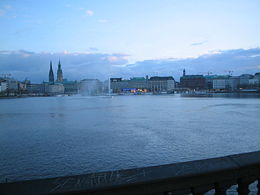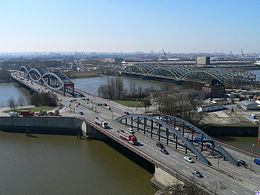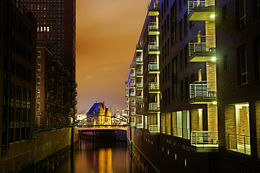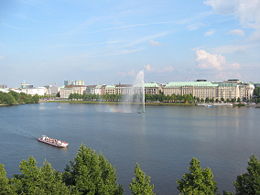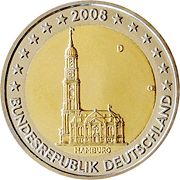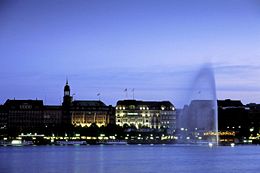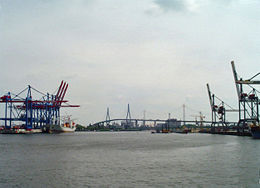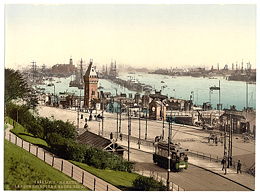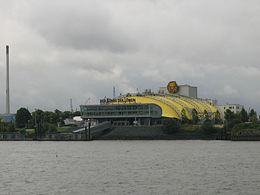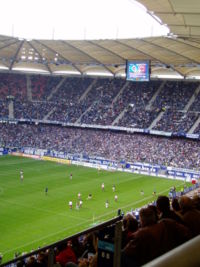Hamburg
2008/9 Schools Wikipedia Selection. Related subjects: Europe; European Cities
| Freie und Hansestadt Hamburg Free and Hanseatic City of Hamburg |
|||
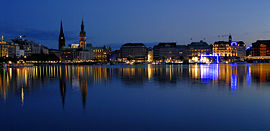 |
|||
| Flag | Coat of arms | ||
|
|||
| Location | |||
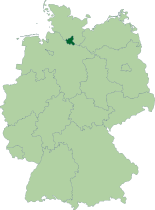 |
|||
| Coordinates | Coordinates: | ||
| Time zone | CET/ CEST ( UTC+1/ +2) | ||
| Administration | |||
| Country | |||
| NUTS Region | |||
| First Mayor | Ole von Beust ( CDU) | ||
| Governing parties | CDU / Alliance '90/The Greens | ||
| Votes in Bundesrat | 3 (of 69) | ||
| Basic statistics | |||
| Area | 755 km² (292 sq mi) | ||
| Population | 1,769,117 (10/2007) | ||
| - Density | 2,343 /km² (6,069 /sq mi) | ||
| Other information | |||
| GDP/ Nominal | € 86,153 billion (2006) | ||
| Postal codes | 20001–21149, 22001–22769 | ||
| Area codes | 040 | ||
| Licence plate code | HH | ||
| Website | hamburg.de | ||
Hamburg (German language: pronounced [ˈhambʊɐk], local pronunciation [ˈhambʊɐç] Low German/ Low Saxon: Hamborg [ˈhaˑmbɔːχ], English: [ˈhæmbəˑg]) is the second-largest city in Germany (after Berlin) and along with Hamburg Harbour, its central port, Hamburg is also the second-largest port in Europe (after Rotterdam), ninth-largest port in the world, and the most populous city in the European Union which is not a national capital. The city contains an approximate 1.8 million inhabitants.
Hamburg's proper name is the Free and Hanseatic City of Hamburg (German: Freie und Hansestadt Hamburg). It makes reference to Hamburg's membership in the medieval Hanseatic League and also to the fact that Hamburg is a city-state and one of the sixteen Federal States of Germany.
Hamburg is located on the southern point of the Jutland Peninsula, directly between Continental Europe to its south, Scandinavia to its north, the North Sea to its west, and the Baltic Sea to its east. Hamburg is located in the position where the River Elbe meets with the rivers Alster and Bille. The central city area is situated around the Binnenalster ("Inner Alster") and the Außenalster ("Outer Alster") both of which are lakes. The island of Neuwerk and two other islands in the North Sea are also part of Hamburg, forming the Hamburg Wadden Sea National Park.
Hamburg is a world-renowned centre of commerce, especially within Northern Germany. It is also a city of diverse cultures, all of which are accepted within the city.
History
The city takes its name from the first permanent building on the site, a castle ordered to be built by Emperor Charlemagne in 808 AD. The castle was built on rocky ground in a marsh between the Alster and the Elbe as a defense against Slavic incursion. The castle was named Hammaburg, where "burg" means "castle". The "Hamma" element remains uncertain. Old High German includes both a hamma, "angle" and a hamme, "pastureland". The angle might refer to a spit of land or to the curvature of a river. However, the language spoken might not have been Old High German, as Low Saxon was spoken there later. Other theories hold that the castle was named for a surrounding Hamma forest, or for the village of Hamm, later incorporated into the city. Hamm as a place name occurs a number of times in Germany, but its meaning is equally uncertain. It could be related to "heim" and Hamburg could have been placed in the territory of the ancient Chamavi. However, a derivation of "home city" is perhaps too direct, as the city was named after the castle. Another theory is that Hamburg comes from ham which is Old Saxon for shore.
In 834 Hamburg was designated the seat of a bishopric, whose first bishop, Ansgar, became known as the Apostle of the North. In 845 a fleet of 600 Viking ships came up the River Elbe and destroyed Hamburg, at that time a town of around 500 inhabitants. Two years later, Hamburg was united with Bremen as the bishopric of Hamburg-Bremen.
In 983, the town was destroyed by King Mstivoj of the Obodrites. In 1030, the city was burned down by King Mieszko II Lambert of Poland. After further raids in 1066 and 1072 the bishop permanently moved to Bremen. Hamburg had several great fires, notably in 1284 and 1842.
The charter in 1189 by Frederick I "Barbarossa" granted Hamburg the status of an Imperial Free City and tax-free access up the Lower Elbe into the North Sea. This charter, along with Hamburg's proximity to the main trade routes of the North Sea and Baltic Sea, quickly made it a major port in Northern Europe. Its trade alliance with Lübeck in 1241 marks the origin and core of the powerful Hanseatic League of trading cities.
In 1529 the city embraced Lutheranism, and Hamburg subsequently received Protestant refugees from the Netherlands and France. Hamburg was at times under Danish sovereignty while remaining part of the Holy Roman Empire as an Imperial Free City.
Briefly annexed by Napoleon I (1810–14), Hamburg suffered severely during his last campaign in Germany. The city was besieged for over a year by Allied forces (mostly Russian, Swedish and German). Russian forces under General Bennigsen finally freed the city in 1814. During the first half of the 19th century a patron goddess with Hamburg's Latin name Hammonia emerged, mostly in romantic and poetic references, and although she has no mythology to call her own, Hammonia became the symbol of the city's spirit during this time.
In 1842, about a quarter of the inner city was destroyed in the "Great Fire". This fire started on the night of the 4 May 1842 and was extinguished on 8 May. It destroyed three churches, the town hall, and countless other buildings. It killed 51 people, and left an estimated 20,000 homeless. Reconstruction took more than 40 years.
Hamburg experienced its fastest growth during the second half of the 19th century, when its population more than quadrupled to 800,000 as the growth of the city's Atlantic trade helped make it Europe's third-largest port.
With Albert Ballin as its director the Hamburg-America Line became the world's largest transatlantic shipping company at the turn of the century, and Hamburg was also home to shipping companies to South America, Africa, India and East Asia. Hamburg became a cosmopolitan metropolis based on worldwide trade. Hamburg was the port for most Germans and Eastern Europeans to leave for the New World and became home to trading communities from all over the world (like a small Chinatown in Altona, Hamburg).
In 1903, the world's first organized club for social and family nudism, Freilichtpark (Free-Light Park) was opened in Hamburg by Paul Zimmerman. It was located on a lake formed by the Alster River in the southern part of the city, adjoining a bathing beach.
After World War I Germany lost her colonies and Hamburg lost many of its trade routes. In 1938 the city boundaries were extended with the Groß-Hamburg-Gesetz ( Greater Hamburg Act) to incorporate Wandsbek, Harburg, Wilhelmsburg and Altona.
During World War II Hamburg suffered a series of devastating air raids which killed 42,000 German civilians (see Bombing of Hamburg in World War II). Through this, and the new zoning guidelines of the 1960s, the inner city lost much of its architectural past.
The Iron Curtain — only 50 kilometres (30 mi) east of Hamburg — separated the city from most of its hinterland and further reduced Hamburg's global trade. On February 16, 1962 a severe storm caused the Elbe to rise to an all-time high, inundating one fifth of Hamburg and killing more than 300 people.
After German reunification in 1990, and the accession of some Eastern European and Baltic States into the EU in 2004, Hamburg Harbour and Hamburg have ambitions for regaining their positions as the region's largest deep-sea port for container shipping and its major commercial and trading centre. Since reunification the Greater Hamburg Metropolitan Region gained about 400,000 inhabitants and in 2007 its population was about 4.3 million people.
Main sights
Churches
The skyline of Hamburg features the high spires of the five principal churches (Hauptkirchen) covered with green copper plates.
- St. Michaeliskirche (Saint Michael's Church, nicknamed “Michel")
- St. Nikolaikirche (Saint Nicholas' Church, memorial)
- St. Petrikirche (Saint Peter's Church, 11th century)
- St. Jacobikirche (Saint Jacob's Church, 13th century)
- St. Katharinenkirche (Saint Catherine's Church, 14th century)
(The dates given correspond to the establishment of the respective parish; the buildings are considerably younger)
Other churches are also visible in the inner city:
- St.Johannis, Harvestehude, Hamburg (Saint John's) at the Außenalster
Bridges and tunnels
Hamburg has a number of prominent buildings from the past and present. The many canals in Hamburg are crossed by over 2,300 bridges — more than Amsterdam (1200) and Venice (400) combined. Hamburg has more bridges inside its city limits than any other city or town on Earth.
- Köhlbrandbrücke
- Freihafen Elbbrücken
- Old Elbe Tunnel (Alter Elbtunnel)
- New Elbe Tunnel (Elbtunnel)
Lombardsbrücke and Kennedybrücke divide Binnenalster from Aussenalster
Towers and masts
- Heinrich-Hertz-Turm
- Transmitter Hamburg-Billstedt
Other sights
- Townhall (Rathaus)
Richly decorated Neo-Renaissance building finished in 1896. With its tower of 112 meters it is Europe's highest townhall. On its facade it shows the emperors of the Holy Roman Empire since Hamburg was, as a Free Imperial City, only under the sovereignty of the emperor.
- Chilehaus
A brick stone office building from 1922 spectacularly shaped like an ocean liner. Designed by architect Fritz Höger.
- Stadtpark
Hamburg's "Central Park" has a great lawn and a huge watertower which houses one of Europe's biggest Planetariums. The park and its buildings were also designed by Fritz Schumacher in the 1910s
- HafenCity
To be completed around 2015 Europe's largest inner city development will house about 10 000 inhabitants and 15 000 workers. Its ambitious planning and architecture (amongst others designs by Rem Kolhaas and Renzo Piano will be realized) are slowly coming into shape. Its location in an abandoned area of the harbour is already drawing tourists. In 2008 the International Maritime Museum will open, By the end of 2009 the Elbphilharmonie – by many considered Germany's most exciting new structure – is scheduled to house its first concerts in a spectacular building designed by the Swiss firm Herzog & de Meuron on top of an old warehouse.
Parks
The many parks of Hamburg are distributed over the whole city, which makes Hamburg a very green city. The biggest parks are the Stadtpark, the cemetery Ohlsdorf and Planten un Blomen.
Culture
Theatres
- Altonaer Theatre
- Theatre Allee
- Schauspielhaus
- Ernst-Deutsch-Theatre
- Hansa Theatre
- Theatre im Zimmer
- English Theatre
- St. Pauli Theatre
- Schmidts Tivoli
- Hamburger Kammerspiele
- Imperial Theater (Hamburg)|Imperial Theatre
- komödie - im Winterhuder Fährhaus
- Thalia-Theatre
- Thalia Gaußstraße
- Monsun Theatre
- Theatre Imago
- Kampnagel-Fabrik
- Theatre für Kinder
- Neues Theatre am Holstenwall
- Theatre in der Basilika
- Schilleroper
- Theaterschiff am Mäuseturm
- Ohnsorg-Theatre—a theatre in which the actors speak Low Saxon (but they speak Missingsch-infused German for national television broadcasts, since Low Saxon is not comprehensible to most German speakers)
Politics of Hamburg
The city of Hamburg is one of 16 German states, therefore the First Mayor of Hamburg's office correspondents more to the role of a minister-president than to the one of a "normal" city mayor. The current First Mayor of Hamburg is Ole von Beust, govern in Germany's first state-wide "black-green" coalition, consisting of the conservative CDU and the alternative Green Party.
Economy
The most significant economic basis for Hamburg is the Hamburg Harbour, which ranks 2nd only to Rotterdam in Europe and 9th worldwide with transshipments of 9.8 million twenty-foot equivalent units (TEU) of cargo and 134 million tons of goods in 2007. After the German reunification, Hamburg recovered the eastern portion of its hinterland, becoming by far the fastest growing port in Europe. International trade is also the reason for the large number of consulates in the city. Although situated 68 miles (110 km) up the Elbe, it is considered a sea harbour due to its ability to handle large ocean-going vessels.
Hamburg, along with Seattle and Toulouse, is one of the most important locations of the civil aerospace industry in the world. Airbus, which has one of its two assembly plants in Hamburg, and related companies employ over 30,000 people in or near the city.
Other important industries are media businesses, most notably four of Germany's largest publishing companies, Axel Springer AG, Gruner + Jahr, Heinrich Bauer Verlag, Der Spiegel and Die Zeit. About half of Germany's national newspapers and magazines are produced in Hamburg. There are also a number of music companies (the largest being Warner Bros. Records Germany) and Internet businesses (e.g. AOL, Adobe Systems and Google Germany, and also Web 2.0 companies like Qype).
Heavy industry includes the making of steel, aluminium and Europe's largest copper plant , and a number of shipyards like Blohm + Voss .
Transport
Hamburg's licence plate prefix is "HH" (Hansestadt Hamburg, English: Hanseatic City of Hamburg), rather than just the single-letter normally used for large cities. The prefix "H" is used in Hanover instead.
As in most larger German cities, public transport is organised by a fare-collection joint venture between transportation companies. Tickets sold by one member company in this Hamburger Verkehrsverbund (Hamburg traffic group) (HVV) are valid on all other HVV companies' services.
HVV acts as an overall coordinating body for transport in the Hamburg combination, with representation by the Hamburger Hochbahn (Hamburger Overhead Railway); Deutsche Bahn (German Federal Railroads); AKN railway company (Altona—Kaltenkirchen—Neumunster Railway); HADAG Seetouristik und Fahrdienst A. G. (HADAG sea-tourism and driving service shares society); VHH (Verkehrsbetriebe Hamburg-Holstein A.G./ Transporting enterprises Hamburg Holstein shares society); PVG (Pinneberger Verkehrsgesellschaft, mbH/ Pinneberger public transport company, Inc); and KVG (Kraftverkehrgesellschaft, GmbH/ Motor Traffic Company, LLC).
Nine mass transit routes across the city are the backbone of Hamburg public transport. Three lines comprise the U-Bahn and six the S-Bahn system. U-Bahn is short for Untergrundbahn (underground railway). Approximately 41 km (25 mi) of 101 km (63 mi) of the U-Bahn is underground; most of the U-Bahn tracks are on embankments or viaducts or at ground level. Older residents still speak of the system as the Hochbahn ("elevated railway"). The Hamburg S-Bahn has a total length of 115.2 km (72 mi) (8 km/5 mi single-track, 10 km/6 mi underground) with 59 stations, of which 10 are underground. A light rail system, the AKN, connects to satellite towns in Schleswig-Holstein. Gaps in the mass-transit network are filled by bus routes, plied by single-deck, two-, three- and four-axle diesel buses. Hamburg has no trams or trolley-buses, but has hydrogen fuelled buses operating pilot services.
Finally, regional trains of Germany's major railway company Deutsche Bahn AG and the regional metronom trains may be used with a HVV public transport ticket, too. Except at the three bigger stations in the centre of Hamburg, the regional trains hardly stop again inside the area of the city.
A 24-hour bus network operates as frequently as every 2 minutes on busy routes (30 minutes in suburban areas). There are six ferry lines along the river Elbe, operated by the HADAG company. While mainly needed by Hamburg citizens and dock workers, they can also be used for sightseeing tours at the (relatively) low fees of a HVV public transport ticket.
Hamburg is connected by four Autobahnen (motorways) and is the most important railway junction on the route to Northern Europe.
Airports
Hamburg Airport is the oldest airport in Germany still in operation. There is also the smaller Hamburg Finkenwerder Airport, used only as a company airport for Airbus. Some airlines market Lübeck Airport in Lübeck as serving Hamburg.
Music
Famous composers connected to Hamburg include:
- Georg Philipp Telemann (1681–1767) died in Hamburg.
- Carl Philipp Emanuel Bach (1714–1788, son of Johann Sebastian Bach) died in Hamburg.
- Felix Mendelssohn (1809–1847) was born in Hamburg.
- Johannes Brahms (1833–1897) was born in Hamburg.
Hamburg and vicinity is a popular residency for famous contemporary classical composers. Hungarian composer György Ligeti (1923–2006) also known for his music in films by Stanley Kubrick lived in Hamburg for 30 years and taught at the local music academy. He was succeeded at the Hochschule by the Russian-German composer Alfred Schnittke (1934–1998) who died in Hamburg. His countrywoman Sofia Gubaidulina (born in 1931) lives on the outskirts of Hamburg. Other important composers living and working in Hamburg are Manfred Stahnke, a pupil of György Ligeti's, Peter Ruzicka, Peter Michael Hamel and Babette Koblenz.
The Hamburg State Opera is one of the leading German opera houses. Its orchestra is the Philharmoniker Hamburg. Hamburg's current Generalmusikdirektorin is Simone Young, music director of both the opera and the orchestra.
Hamburg's most prestigious orchestra is the North German Radio Symphony Orchestra.
Hamburg's main concert venue is the Laeiszhalle-Musikhalle, pending the completion of the Elbphilharmonie Hamburg. The Musikhalle which is the home of the Hamburger Symphoniker.
St. Pauli
St. Pauli is usually associated with the street of Reeperbahn, a synonym for one of the world's most famous red light districts. Singer and actor Hans Albers is strongly associated with St. Pauli, providing in the 1940s the neighbourhood's unofficial anthem, "Auf der Reeperbahn Nachts um Halb Eins." The song explains in a polite way how a sailor enjoys his last day with a trollop before going aboard. St. Pauli is known for giving the Beatles a start in their musical career in the early 1960s. The Beatles lived in St. Pauli and played at the Indra and the Kaiserkeller (1960), the Top Ten Club (1961), and the Star-Club (1962), which was located in the district near the perhaps most famous street of Hamburg, the Reeperbahn. St. Pauli is also known as a centre for the German punk movement.
Contemporary popular
Nena lives in Hamburg. Sascha Konietzko the frontman and founder of KMFDM is from Hamburg and visits regularly. More recently it is known for some of the most popular German hip hop acts, such as Fünf Sterne deluxe, Samy Deluxe, Beginner and Fettes Brot. There is also a quite big alternative and punk scene which gathers around the Rote Flora , an occupied former theatre located in the district of Sternschanze. Some of the musicians of the famous electronic band Kraftwerk also came from Hamburg. In addition, the members of Tokio Hotel currently reside in Hamburg. Other Hamburg residents include German comedic troop Studio Braun and comedian Helge Schneider. The seemstress Floriana Schmidtess resides in the St. George neighbourhood and counts among the city's elite.
Hamburg is also famous for an original kind of German alternative music called Hamburger Schule ("Hamburg School"), a term used for bands like Tocotronic, Blumfeld, Die Sterne and Tomte.
Hamburg was one of the major centres of the heavy metal music world in the 1980s. Many bands such as Helloween, Running Wild and Grave Digger got their start in Hamburg. The influences of these bands and other bands from the area were critical to establishing the subgenre of Power metal.
Hamburg is also one of the most important global centres for psychedelic trance music. It is home to many record labels such as Spirit Zone, [Mushroom Magazine, the world's best known and longest running psy-trance magazine, as well as many parties and club nights. During the summer people from all over the world flock to the countryside surrounding Hamburg to attend massive festivals such as Voov Experience, Shiva Moon, Tshitraka and Fusion Festival.
Since the German premiere of Cats in 1985 there are always a number of musicals being played in the city. Among them have been Phantom of the Opera, The Lion King or Dirty Dancing (before there was Dance of the Vampires). This density, which is the highest in Germany, is partly due to Germany's major musical production company Stage Entertainment being located in Hamburg. One of the musical theatres is a large tent in the harbour, guests either arrive by boat or through the historic Old Elbe Tunnel.
Hamburg was one city to take part in the Complaints Choir project. Meg Weymes is also a celebrity from Hamburg.
Museums
Currently Hamburg has 79 museums. Famous and popular ones include:
- Altona Museum and North German State Museum
- Art Gallery and Gallery of Contemporary Arts and ( Kunsthalle Hamburg und Galerie der Gegenwart)
- BallinStadt - The History of Emigration
- Bucerius Kunst Forum
- Deutsches Zollmuseum
- Erotic Art Museum
- Hamburg Dungeon
- Hamburg Museum for Archaeology and the History of Harburg
- Neuengamme concentration camp memorial
- Helms-Museum
- Johannes-Brahms-Museum
- Hamburger SV Museum
- Museum of Art and Design (Museum für Kunst und Gewerbe)
- Museum of Communication (Museum für Kommunikation)
- Museum of Ethnography (Museum für Völkerkunde)
- Museum of Hamburg History (Museum für Hamburgische Geschichte)
- Museum of Labour (Museum der Arbeit) , an Anchor Point of ERIH, The European Route of Industrial Heritage
- Speicherstadt Museum
- St. Pauli Museum
- See also: List of museums in Hamburg in the German Wikipedia
Cuisine
Hamburg is the birthplace of the Hamburger. This is not a myth. The beef patties a German immigrant from Hamburg sold in the 1850s in New York allegedly were named after the butcher and then became a generic term.
Original Hamburg dishes are Bohnen, Birnen und Speck (Low Saxon Bohn, Peern un Speck, green runner beans cooked with pears and bacon), Aalsuppe (Low Saxon Oolsupp, often mistaken to be German for "eel soup" (Aal/Ool ‘eel’), however the name probably comes from the Low Saxon allns [ʔaˑlns], meaning “all”, “everything and the kitchen sink”, not necessarily eel. Today eel is often included to meet the expectations of unsuspecting diners.), Bratkartoffeln (Low Saxon Brootkartüffeln, pan-fried potato slices), Finkenwerder Scholle (Low Saxon Finkwarder Scholl, pan-fried plaice), Pannfisch (pan-fried fish), Rote Grütze (Low Saxon Rode Grütt, related to Danish rødgrød, a type of summer pudding made mostly from berries and usually served with cream, like Danish rødgrød med fløde) and Labskaus (a mixture of corned beef, mashed potatoes and beetroot, a cousin of the Norwegian lapskaus and Liverpool's lobscouse, all offshoots off an old-time one-pot meal that used to be the main component of the common sailor's humdrum diet on the high seas).
Hamburg is the birthplace of Alsterwasser (a reference to the city's river Alster with two lake-like bodies in the city centre thanks to damming), a type of shandy, a concoction of equal parts of beer and carbonated lemonade (Zitronenlimonade), the lemonade being added to the beer. Hamburg is also home to a curious regional dessert pastry called Franzbrötchen. Looking rather like a flattened croissant, the Franzbrötchen is somewhat similar in preparation but includes a cinnamon and sugar filling, often with raisins or brown sugar streusel. The name may also reflect to the roll's croissant-like appearance -- franz appears to be a shortening of französisch, meaning "French", which would make a Franzbrötchen a “French roll.” Being a Hamburg regional food, the Franzbrötchen becomes quite scarce outside the borders of the city; as near as Lunenburg ( Lüneburg) it can only be found as a Hamburger and is not to be had in Bremen at all.
Ordinary bread rolls—without which a leisurely weekend breakfast in Hamburg is unimaginable—tend to be oval-shaped and of the French bread variety. The local name is Rundstück (“round piece” rather than mainstream German Brötchen, diminutive form of Brot “bread”) , a relative of Denmark's rundstykke. In fact, while by no means identical, the cuisines of Hamburg and Denmark, especially of Copenhagen have a lot in common. This also includes a predilection for open-faced sandwiches of all sorts, especially topped with cold-smoked or pickled fish. The American hamburger seems to have developed from Hamburg's Frikadelle (or Frikandelle): a pan-fried patty (usually larger and thicker than the American counterpart) made from a mixture of ground beef, soaked stale bread, egg, chopped onion, salt and pepper, usually served with potatoes and vegetables like any other piece of meat, not usually on a bun. (Many Hamburgers consider their Frikadelle and the American hamburger different, virtually unrelated “creatures.”)
Sports
Hamburg is considered Germany's capital of sports since no other city is home to more first league teams and international sports events. Hamburger SV, the most successful team in Hamburg, is a football team in the Bundesliga (which has played in the group stages of the Champions League twice; in 2000/2001 and in 2006/2007). HSV is a six time German champion, a three time German cup winner and triumphed in the European cup in 1977 and 1983. The most famous players in its history are Uwe Seeler, Kevin Keegan, Manfred Kaltz, Felix Magath, Horst Hrubesch, Franz Beckenbauer and Rafael van der Vaart. They play at the HSH Nordbank Arena (average attendance in the 06/07 season was 56 100). The Hamburg Freezers represent Hamburg in the DEL, the highest ice hockey league in Germany. The HSV Handball represents Hamburg in the German handball league. In 2007 HSV Handball won the European Cupwinners Cup. Both teams play in the ultra-modern Colour Line Arena. Additionally FC St. Pauli is a second division (formerly third League) football club. They play at the Millerntor-Stadion which they regularly sell out and are world famous for their anti racist, anti sexist, actively anti Neo-Nazi and left-leaning fans. Hamburg is the nation's hockey capital and dominates the men's as well as the women's Bundesliga with teams like Der Club an der Alster, Großflottbeker THGC, Harvestehuder THC, Klipper THC or Uhlenhorster HC. There are also several minority sports clubs, surprisingly Hamburg has four cricket clubs, Alster CC, HSV Cricket, Pak Alemi CC and Hamburg International CC. Hamburg is also home to the Hamburg Dockers Australian Rules Football club which compete in the German Australian Football League. The FC St.Pauli dominates women's Rugby in Germany. Other first league teams include NA Hamburg (Volleyball), Hamburger Polo Club, Blue Devils (American Football). The Centre Court of Tennis Stadium Rothenbaum with a capacity of 13000 people is the fifth largest in the world and home to the German Open. Hamburg also hosts Germany's most prestigious equestrian events at Reitstadion Klein Flottbek (Deutsches Derby in jumping and dressage) and Horner Rennbahn (Deutsches Derby racing). The Hamburg Marathon (18 000 participants), Worldcups in Cycling and Triathlon are also held here.
The HSH Nordbank Arena (formerly the AOL Arena and originally Volksparkstadion) was used a site for the 2006 World Cup.
See also: Deutsches Derby
Religion
41% of inhabitants are Christians, 10% of them being Catholics. Muslims (mostly Sunni) are 12% of the population. About 39% profess no religion. There are also large numbers of Hindus and Sikhs.
Language
As elsewhere in Northern Germany, the original language of Hamburg is Low Saxon, usually referred to as Hamborger Platt (German Hamburger Platt) or Hamborgsch. It is still in use, albeit by a minority and rarely in public, probably due to a hostile climate between World War II and the early 1980s. Since large-scale Germanisation beginning in earnest with in the 18th century, various Low German-coloured dialects have developed (contact-varieties of German on Low Saxon substrates). Originally, there was a range of such Missingsch varieties, best known being the low-prestige ones of the working classes and the somewhat more “posh” bourgeois Hanseatendeutsch. All of these are now moribund due to the influences of “proper” German propagated by education and media, perhaps also because of gradual erosion of the erstwhile independent spirit and local pride of Hamburg's population. However, the former importance of Low German is indicated by several songs, such as the famous sea shanty Hamborger Veermaster, written in the 19th century when Low German was used more frequently.
In addition, immigration brought numerous dialects from all over the German-speaking world used to Hamburg, also a large number of foreign language communities. Hamburg has a sizeable population of Sinti and Roma (“Gypsy”) people, some of them sedentary (mostly Sinti) and some of them nomadic or semi-nomadic (mostly Roma), camp grounds being set aside by the state and municipal governments. Hamburg is thus one of the few locations in the world in which both Sinti and Romany are spoken, and it is also one of the major headquarters of international Roma organisations.
Education
There are 245 primary schools, 195 secondary schools and 33 libraries in Hamburg proper.
Universities
Currently, up to 29 institutions of tertiary education are located in Hamburg:
- AMD - Akademie für Mode & Design website
- BAH - Berufsakademie Hamburg website
- BLS - Bucerius Law School - Hochschule für Rechtswissenschaft website
- EBC - Euro-Business College Hamburg website
- Euro-FH - Europäische Fernhochschule Hamburg - European University of Applied Sciences Hamburg website
- EvFH - Evangelische Fachhochschule für Sozialpädagogik, Soziale Arbeit und Diakonie website
- FHÖV - Fachhochschule für Öffentliche Verwaltung Hamburg website
- FOM - Fachhochschule für Oekonomie und Management Studienort Hamburg website
- FüAkBw - Führungsakademie der Bundeswehr website
- HAW - Hochschule für Angewandte Wissenschaften - Hamburg University of Applied Sciences website
- HCU - HafenCity University for Architecture, City Planning, Structural Development and Geomatics website
- HfbK - Hochschule für bildende Künste Hamburg website
- HfF - Hochschule für Finanzen (website not available yet)
- HFH - Hamburger Fern-Hochschule website
- HfMT - Hochschule für Musik und Theatre Hamburg website
- HH - Hotelfachschule Hamburg website
- HMS - Hamburg Media School website
- HSBA - Hamburg School of Business Administration website
- HSU - Helmut Schmidt Universität / Universität der Bundeswehr Hamburg - Helmut Schmidt University / University of the Federal Armed Forces Hamburg website
- HWP - Hamburger Universität für Wirtschaft und Politik website
- ICoM- International College of Music, Hamburg website
- JAK - Akademie JAK Modedesign website
- NIT - Northern Institute of Technology website
- SSH - Stage School Hamburg website
- TUHH - Technische Universität Hamburg-Harburg - Hamburg University of Technology website
- UHH - Universität Hamburg - University of Hamburg website
- University Medical Centre Hamburg-Eppendorf website
- WAHH - Wirtschaftsakademie Hamburg website
- ZMNH - Zentrum für Molekulare Neurobiologie Hamburg - Centre for Molecular Neurobiology Hamburg
Tourism
Tourists play a significant role in the city's economy, and according to the magazine Travelhouse Media two of the most visited sites in Germany are located here: the harbour (8 million visitors per year) and the Reeperbahn (4 million), compared to famous sites like the Cathedral in Cologne (6 million) or the castle Neuschwanstein (200,000) unexpected high numbers to most people. Hamburg has the fastest growing tourism industry in Germany (2005 and 2006 approx. 15%) and will most probably reach rank 10 of Europe's most visited tourist destinations by 2008.
Hamburg is best visited in spring or summer. A typical Hamburg visit includes a tour of the city hall and the grand church St. Michaelis (called the Michel), and visiting the old warehouse district (Speicherstadt) and the harbour promenade (Landungsbrücken). Sightseeing buses connect these points of interest. Of course, a visit in one of the world's largest harbours would be incomplete without having taken one of the harbour and/or canal boat tours (Große Hafenrundfahrt, Fleetfahrt) which start from the Landungsbrücken. Many visitors, especially those with a taste for the low life, take a walk in the evening around the area of Reeperbahn, considered Europe's largest red light district and home of many strip clubs, bars and nightclubs. It was in the Reeperbahn that The Beatles began their career with a 48-night residency at the Indra Club, and then another 58 nights at the Kaiserkeller, in 1960. Others prefer the laidback Schanze district with its street cafés or a barbecue on one of the beaches along the river Elbe. Hamburg's famous zoo, the Tierpark Hagenbeck, was founded in 1907 by Carl Hagenbeck as the first zoo with moated, barless enclosures. A friend of Hagenbeck's, the illustrator Heinrich Leutemann made some illustrations here.
Quite common is a tour through Northern Germany with Hamburg as a starting point or stop-over.
However, most people visit Hamburg because of a specific interest, notably one of the musicals, a sports event, a congress or fair. Therefore, in 2005, the average visitor spent two nights in Hamburg. The majority of visitors come from Germany (80%); most foreigners are European, especially from the United Kingdom and Switzerland, and the largest group from outside Europe comes from the U.S. An interesting footnote is the high number of rich guests from the Arabian peninsula, who seek treatment in one of Hamburg's hospitals.
Regular events
For the interested visitor, some events held every year:
- Sports (Note that a registration, usually months in advance, is needed for public races.)
- Hamburg Marathon — marathon, open to the public: April
- Tennis Masters Series Am Rothenbaum : May
- HSH Nordbank Run, open to the public. Race through the HafenCity (HarbourCity): May
- Hamburg Masters — Hockey 4 Nations Trophy: August
- Dragon boat race, open to the public: August
- Cyclassics — UCI-ProTour bike race, open to the public: August
- Hamburg City Man Triathlon — triathlon, open to the public: August
- Film festivals
- Filmfest Hamburg : September
- Fantasy Filmfest : April
- Kurzfilmfestival — International Short Film Festival : June
- Lateinamerika-Filmtage — Latin-America Days : December
- Spanische Filmtage — Spanish Days : July
- Lesbian & Gay Film Festival Hamburg : October
- Arts and exhibitions
- International Fireworks Festival: August
- Kirschblütenfest — Grand fireworks and Japanese culture: May
- Lange Nacht der Museen — one ticket, 40 of Hamburg's museums open until midnight: May
- PHP Unconference — Yearly two-day PHP Conference : April
- Theme nights (jungle, romantic, Asian) at Hagenbeck's zoo : Saturdays in summer
- Music
- Fleetinselfest — Music and international artists open air : July
- G-Move — Techno parade (until 2005, since 2006 taking place at the city of Kiel)
- Schlagermove — German 1960s / 1970s music parade : July
- Reeperbahn Festival — huge Indoor Musicfestival in many Clubs of the Red-Light-District in St. Pauli, mostly Rock, Alternative and Indie-music: September
- Fun / Street festivals
- Alstervergnügen — Alster fair: first weekend of September
- Christopher Street Day (Gay Pride Parade) : June
- Hamburger Dom — considered the largest funfair in northern Germany: three times a year
- Hafengeburtstag — Hamburg's harbour birthday: May
- Motorradgottesdienst — Biker's divine service in Hamburg's largest church St. Michaelis: June
Sister cities
 Chicago, United States, since 1994
Chicago, United States, since 1994 Dresden, Germany (then East Germany), since 1987
Dresden, Germany (then East Germany), since 1987 León, Nicaragua, since 1989
León, Nicaragua, since 1989 Marseille, France, since 1958
Marseille, France, since 1958 Osaka, Japan, since 1989
Osaka, Japan, since 1989 Prague, Czech Republic, since 1990
Prague, Czech Republic, since 1990 St. Petersburg, Russia, then Soviet Union, since 1957
St. Petersburg, Russia, then Soviet Union, since 1957 Shanghai, People's Republic of China, since 1986
Shanghai, People's Republic of China, since 1986
More information: Hamburg sister cities (in German only)
Famous people born in Hamburg
- Sportspeople
- Andreas Brehme, born in 1960, football coach and former football defender
- Stefan Effenberg, born in 1968, former soccer player and football player
- Tommy Haas, born in 1978, tennis player
- Max Schmeling, 1905–2005, German boxer and heavyweight champion
- Uwe Seeler, born in 1936, football manager and former football player
- Politicians
- Helmut Schmidt, born in 1918, German Social Democratic politician and former Chancellor of Germany (1974-1982)
- Angela Merkel, born in 1954 Chancellor of Germany
- Entertainment
- Fatih Akin, born in 1973, film director
- Hans Albers, 1891–1960, actor and singer
- Samy Deluxe, born in 1977, hip hop artist, writer and producer
- Felix Mendelssohn Bartholdy, 1809–1847, composer
- Johannes Brahms, 1833–1897, composer
- Oliver Hirschbiegel, born in 1957, film director
- Astrid Kirchherr, born in 1938, photographer and artist
- Oliver Uckermann, founder and male vocalist of band Stillste Stund
- Michael Kiske, Michael Weikath, Kai Hansen, Ingo Schwichtenberg and Markus Grosskopf of Helloween, power metal band
- Writers
- Rudolf Augstein, 1923–2002, writer
- Wolfgang Borchert, 1921–1947, author and playwright
- Marion Dönhoff, 1909–2002, writer
- Henri Nannen, 1913–1996, writer
- Fashion designers
- Karl Lagerfeld, born in 1933, fashion designer
- Scientists
- Michael Artin, born in 1934, mathematician, professor at MIT
- Heinrich Rudolf Hertz, 1857–1894, physicist and electronic engineer
- Painters
- Daniel Richter, born in 1962, painter
- Others
- Albert Ballin, 1857–1918, businessman
- Paul Carl Beiersdorf, 1836–1896, pharmacist
- Helmuth Hübener, 1925–1942, youngest opponent of the Third Reich to be sentenced to death and executed.
- See also
- List of Honorary Citizens of Hamburg
More impressions


